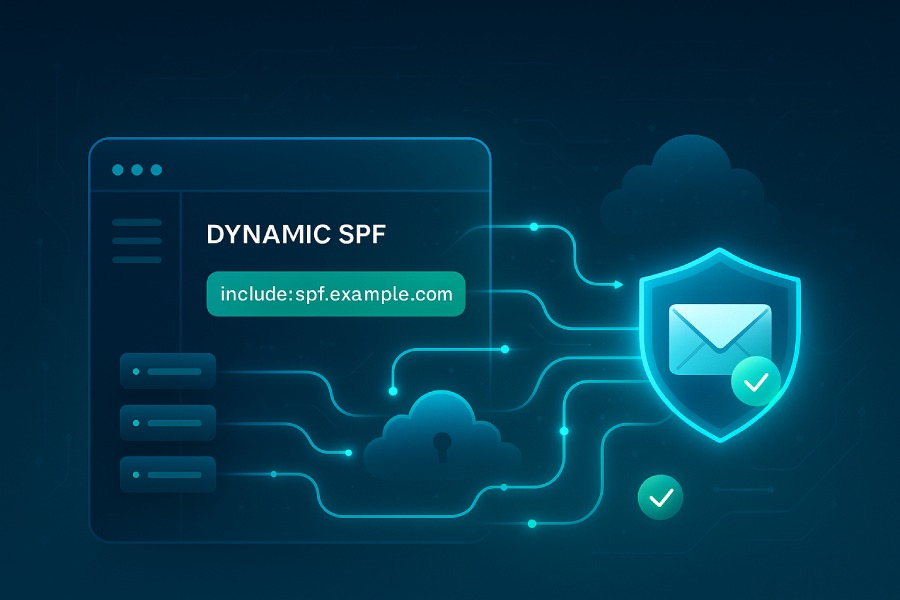Understanding SPF: A Primer on Sender Policy Framework
The Sender Policy Framework (SPF) serves as a cornerstone technology in email authentication and protection against email spoofing, a prevalent technique in email fraud and phishing attacks. At its core, SPF is a DNS-based email authentication method that enables domain owners to specify authorized mail servers permitted to send email on their behalf. This specification is carried out through a DNS TXT record known as an SPF record.
When a Mail Transfer Agent (MTA) receives an inbound email, it performs an SPF check by conducting an SPF lookup against the domain’s SPF record to validate the sending server’s IP address. This SPF validation process helps to enforce email policy enforcement by confirming that the email originated from an authorized source, thereby thwarting attempts at email spoofing and bolstering email security.
The SPF record is defined using SPF syntax, which includes various SPF mechanisms (such as “ip4,” “include,” or “a”) and SPF modifiers that determine how the mail server’s IP addresses are evaluated. The evaluation can result in outcomes such as SPF pass, SPF fail (hardfail), SPF softfail, or SPF neutral, each influencing the handling of the email by dynamic email filtering or anti-spam systems.
Organizations often complement SPF with other email authentication protocols like DKIM (DomainKeys Identified Mail) and DMARC (Domain-based Message Authentication, Reporting & Conformance) to enhance protection through SPF alignment and domain verification.
The Evolution from Static to Dynamic SPF Records
Traditional SPF records are static, requiring manual updates to the DNS TXT record whenever email servers or sending services change. This poses challenges for modern businesses that rely on multiple cloud-based email security providers and third-party email services such as Microsoft Exchange, Google Workspace, SendGrid, and Amazon SES. Each of these services may have varying sending IP addresses that need to be constantly enumerated within the SPF record.
Moreover, static SPF records face obstacles like the SPF record length limit and DNS propagation delay, limiting the number of IP addresses or “include” statements a domain’s SPF record can contain. To circumvent these constraints, many organizations utilize SPF flattening tools to reduce record size, but these require regular SPF record management and can introduce errors or delayed SPF record updates.

Dynamic SPF records emerged as a sophisticated solution to these limitations. Through dynamic SPF record generation and SPF record automation, businesses can update and propagate SPF records in real time, adapting to changes in their sending infrastructure without manual DNS TXT record edits. Dynamic DNS systems integrated with email platforms enable this, enhancing SPF enumeration and failover capabilities, essential for complex mail server configurations and IP address whitelisting.
How Dynamic SPF Works: Technical Overview
Dynamic SPF leverages intelligent, programmatic DNS TXT record configuration that automatically updates SPF records based on the active mailing sources. It utilizes dynamic DNS updates and integration with cloud-based email security solutions such as Cloudflare or Valimail for real-time SPF record propagation, eliminating the delays typical of traditional static SPF management.
Instead of hardcoding all authorized IP addresses and third-party domains, dynamic SPF uses mechanisms that can respond to SPF lookups with variable data. For example, when an SPF check occurs, the DNS server dynamically generates the SPF response, incorporating valid IP addresses at query time. This method combats SPF syntax errors and avoids exceeding SPF record length limits, as unnecessary IP addresses are excluded by design.
Dynamic SPF also supports SPF failover and prioritization, ensuring that if a primary mail transfer agent becomes unreachable, alternative servers automatically assume sending capabilities without SPF validation failures. The integration with email header analysis tools and SPF record testing tools provided by platforms like Dmarcian, EasyDMARC, or Google Postmaster Tools ensures continuous SPF configuration accuracy and email deliverability enhancement.
Furthermore, dynamic SPF complements other email fraud prevention layers by working in tandem with DKIM and DMARC protocols. This layered defense increases protection against email phishing protection efforts and enforces stronger domain verification and email policy enforcement strategies.
Benefits of Dynamic SPF Over Traditional Static SPF
Dynamic SPF offers a myriad of benefits that address the inherent challenges of static SPF records:
- Enhanced Email Deliverability: Real-time SPF record updates ensure that authorized senders are always correctly enumerated, reducing SPF softfail or hardfail results that could cause legitimate emails to be marked as spam by providers like Mimecast, Proofpoint, or Barracuda Networks.
- Reduced Administrative Overhead: SPF record automation and dynamic SPF record management decrease the need for manual DNS TXT record editing, minimizing human errors and SPF syntax errors that can lead to SPF check failures.
- Scalability: Dynamic SPF overcomes SPF record length limits and helps maintain NAT transparency with SPF flattening, making it suitable for enterprises leveraging diverse platforms such as Alibaba Cloud Email, Zoho Mail, Mailgun, or Sendinblue.
- Improved SPF Enumeration: Dynamic SPF reduces excessive DNS lookups from nested includes, which can cause SPF validation issues or exceed DNS query limits outlined by the OpenSPF standard, enhancing mail server configuration flexibility.
- Better Failover and Redundancy: With SPF failover mechanisms, organizations can ensure uninterrupted email delivery during infrastructure failures, critical for enterprises using multi-cloud email platforms and hybrid mail infrastructures involving Microsoft Exchange or G Suite.
- Integration With Modern Security Ecosystems: Dynamic SPF plays well with cloud-based email security providers like Cisco IronPort and Palo Alto Networks Prisma SaaS, integrating seamlessly into broad anti-spam, email policy enforcement, and email phishing protection frameworks.

Challenges with Static SPF for Modern Businesses
Many businesses continue to rely on static SPF configurations despite evolving email threats and infrastructural complexities. This reliance brings about several challenges:
- DNS Propagation Delay: Static DNS TXT records require manual updates followed by propagation across global DNS caches. This delay can create windows of vulnerability during which unauthorized sources may send spoofed messages or legitimate email flow may be blocked.
- SPF Record Length Limit: Due to the DNS TXT record size restriction (commonly 255 characters per string and a total size limit), complex SPF records supporting multiple third-party vendors must be flattened or simplified. These practices increase maintenance costs and risk SPF syntax errors.
- Dynamic Mailing Sources: With the rise of dynamic DNS and cloud email services (such as Postmark, SparkPost, or Mailchimp), static SPF configurations struggle to keep pace with fluctuating IP address ranges, leading to SPF enumeration issues and SPF check failures.
- SPF Enumeration and Lookup Limits: Each SPF lookup during SPF validation consumes DNS query resources; static SPF records with multiple include statements risk exceeding lookup limits of 10 queries, leading to SPF neutral or softfail results. This impacts email deliverability and anti-spam effectiveness.
- Limited Failover Options: Static SPF records lack native support for SPF failover. Mail servers and email administrators have limited flexibility in defining SPF policies that handle sudden infrastructure changes or failovers without manual intervention.
- Complicated Mail Server Configuration: Maintaining accurate static SPF records that account for multiple MTAs, reverse DNS configurations, and IP address whitelisting can be cumbersome, especially for businesses interacting with diverse third-party security providers such as Symantec Email Security.cloud or Trend Micro Email Security.
Dynamic SPF addresses these challenges by providing an adaptive architecture that supports continuous SPF record updates integrated with automated SPF record generators and SPF record testing tools. Businesses utilizing advanced email security ecosystems like Trustwave Email Security and McAfee Email Protection benefit significantly from dynamic SPF’s responsiveness and accuracy, ensuring both prevention of email spoofing and robust email fraud prevention capabilities.
Real-World Scenarios Where Dynamic SPF Excels
Dynamic Sender Policy Framework (SPF) configurations leverage the flexibility of Dynamic DNS and automated SPF record management to cater to the complex and ever-evolving email environments of modern enterprises. Organizations utilizing multiple mail transfer agents (MTAs) such as Microsoft Exchange, Amazon SES, and SendGrid often face the challenge of frequent IP address changes. These changes, if reflected statically in an SPF record, can exceed the SPF record length limit, leading to SPF syntax errors or failed SPF checks during SPF validation.
Dynamic SPF record generation strategically addresses these issues by automating SPF record updates and flattening, ensuring efficient SPF lookup while maintaining SPF syntax integrity. This enables seamless SPF failover mechanisms and supports SPF enumeration across different sending sources. Providers like Cloudflare and Valimail have developed robust SPF record automation tools that integrate dynamic SPF policies, enabling real-time domain verification and SPF record propagation with minimal DNS propagation delay.

For instance, organizations deploying cloud-based email security solutions such as Proofpoint, Mimecast, or Cisco IronPort benefit from dynamic SPF by aligning their SPF mechanism dynamically with their evolving IP address infrastructures. This adaptability significantly reduces SPF softfail or SPF hardfail results which would otherwise harm email deliverability and anti-spam effectiveness.
The Role of Dynamic SPF in Combating Email Spoofing
Email spoofing remains a persistent threat to email security, contributing extensively to phishing attacks and email fraud. Dynamic SPF configurations play a pivotal role in email spoofing prevention by dynamically adjusting SPF policies to validate legitimate sources accurately. Unlike static SPF records prone to stale IP listings and DNS-based email authentication failures, dynamic SPF supports constant SPF record updates reflecting changes in sending IPs and mail server configurations.
Dynamic DNS integration allows rapid alterations to the DNS TXT record containing the SPF record, ensuring high fidelity in SPF alignment. This becomes crucial when handling mail servers with rotating IP addresses or in multi-cloud architectures, where static records often fail. SPF modifiers, in conjunction with mail server configuration best practices, facilitate scalable SPF check workflows that robustly mitigate unauthorized sending attempts, thereby strengthening email phishing protection.
Furthermore, dynamic SPF capabilities complement other anti-spam mechanisms by enhancing dynamic email filtering accuracy, reducing false positives, and reinforcing the overall trustworthiness of outbound messages. This dynamic approach contrasts favorably with the traditional Sender ID framework, offering improved granularity and resilience against spoofing.
Integration of Dynamic SPF with DMARC and DKIM
Effective email authentication is contingent on the harmonized implementation of SPF, DKIM (DomainKeys Identified Mail), and DMARC (Domain-based Message Authentication, Reporting & Conformance). Dynamic SPF, when integrated with DKIM and DMARC, forms a comprehensive defensive framework that assures email policy enforcement across multiple vectors.
Dynamic SPF ensures continuous SPF alignment by consistently updating SPF records in the DNS TXT record to reflect legitimate sending sources accurately. DKIM adds an additional layer by cryptographically signing email headers, while DMARC policies direct receivers on handling emails failing authentication checks. Organizations employing platforms like Google Workspace, G Suite, or Zoho Mail often utilize tools such as Dmarcian or EasyDMARC to monitor and analyze sender authentication results, including those influenced by dynamic SPF configurations.
In this integration, DMARC leverages SPF record management to determine SPF check outcomes, helping enforce policies such as quarantine or reject for spoofed emails. Dynamic SPF automation supports SPF record prioritization and failovers, ensuring SPF softfail or SPF neutral designations transition toward stronger SPF hardfail results aligned with DMARC policies. This synergy substantially improves email fraud prevention and enhances domain reputation.
Impact of Dynamic SPF on Email Deliverability and Trust
Email deliverability hinges directly on the robustness of DNS-based email authentication systems. Dynamic SPF’s influence on email deliverability is significant, as it minimizes the occurrence of SPF-related failures that could otherwise funnel legitimate emails to spam or junk folders.
By facilitating dynamic SPF record updates and flattening, organizations avoid the pitfalls of excessively large SPF records that burden mail transfer agents and increase the risk of SPF syntax errors. Integration with mail server configuration best practices, including IP address whitelisting and reverse DNS settings, ensures smooth SPF lookup during mail transport. Dynamic SPF thus promotes consistent SPF validation success rates.

Cloud-based email security solutions like Trend Micro Email Security, Symantec Email Security.cloud, and McAfee Email Protection incorporate dynamic SPF mechanisms to enhance email phishing protection further, boosting overall trust in sender domains. Accurate SPF alignment in concert with DKIM and DMARC reassures receiving Mail Transfer Agents (MTAs) and anti-spam services such as Spamhaus and Trustwave Email Security that legitimate emails are authenticated, consequently elevating sender reputation metrics observed via tools like Google Postmaster Tools.
Case Studies: Businesses Successfully Using Dynamic SPF
Several high-profile organizations have adopted dynamic SPF to streamline their email security and deliverability frameworks. For example, an enterprise utilizing Microsoft Exchange alongside SendGrid and Amazon SES reported a significant reduction in email spoofing incidents after implementing dynamic SPF record automation via Valimail’s cloud-based email security platform. The dynamic SPF integration enabled efficient SPF record propagation and reduction in SPF enumeration overhead.
Another case involves an e-commerce company leveraging Google Workspace and Postmark for transactional emails. They achieved near-perfect SPF alignment and reduced SPF failover issues by deploying dynamic SPF record generation tools supported by SPF record testing utilities from OpenSPF and EasyDMARC. This led to improved email deliverability and a notable decrease in customer support complaints related to missing or flagged emails.
Similarly, a multinational marketing firm using Mailchimp and Sendinblue integrated dynamic SPF with their DMARC enforcement policies, supported by continuous SPF check monitoring through Dmarcian. This holistic approach prevented email header analysis failures and bolstered their anti-spam defenses, substantially increasing email trust scores across all receiving MTAs.
Implementation Strategies for Dynamic SPF in Organizations
Implementing dynamic SPF requires a strategic approach involving multi-layer coordination among IT, cybersecurity, and email operations teams. The process typically begins with an audit of existing SPF records, using SPF record testing tools to identify SPF syntax errors, SPF record length limits, and outdated IP address entries.
Organizations operating multiple cloud and on-premise mail servers—such as those leveraging Microsoft Exchange, G Suite, Alibaba Cloud Email, and Cisco Email Security—should centralize SPF record management using automation platforms like Valimail or Dmarcian. These platforms facilitate dynamic SPF record updates and SPF flattening critical for managing SPF enumeration and avoiding recursive DNS lookups.
Simultaneously, email policy enforcement must incorporate DMARC and DKIM alongside dynamic SPF mechanisms to establish a multi-tiered authentication strategy. Dynamic SPF record generator tools allow IT teams to implement SPF modifiers that support SPF softfail and SPF hardfail semantics as per organizational risk appetite. Additionally, dynamic SPF configurations should be synchronized with reverse DNS and IP address whitelisting protocols to optimize SPF validation by receiving MTAs.
Due consideration must be given to potential DNS propagation delay when rolling out dynamic SPF changes; scheduling SPF record propagation during low-impact windows minimizes disruption to email deliverability. Leveraging cloud-based email security providers such as Palo Alto Networks Prisma SaaS or Cisco IronPort can aid in monitoring SPF record propagation and enforcing dynamic email filtering rules.
Finally, organizations are encouraged to establish continuous SPF check and email header analysis routines using dashboards from Google Postmaster Tools and EasyDMARC, ensuring proactive detection of any SPF alignment issues or SPF enumeration anomalies that might affect overall Email authentication efficacy and Email security posture.
Tools and Solutions Supporting Dynamic SPF Deployment
Dynamic SPF deployment, leveraging the Sender Policy Framework as a DNS-based email authentication standard, demands robust tools and solutions to ensure seamless SPF record management and configuration. Several professional platforms and services facilitate dynamic SPF record generation, automation, and validation to combat email spoofing effectively and enhance email deliverability.
One essential component in this landscape is advanced SPF record generators like those provided by Valimail and Dmarcian, which assist organizations in crafting SPF policies that are compliant with SPF syntax while respecting the SPF record length limit. These tools often integrate features such as SPF record automation, enabling continuous SPF record updates and SPF flattening to streamline the DNS TXT record management.
For enterprises using major mail transfer agents like Microsoft Exchange, Google Workspace (G Suite), or cloud-based services like Amazon SES and SendGrid, numerous email security solutions such as Proofpoint, Barracuda Networks, and Mimecast offer integrated DNS-based email authentication capabilities. These platforms provide dynamic email filtering paired with real-time SPF checks, addressing SPF softfail, hardfail, and neutral results to enhance email policy enforcement and bolster email fraud prevention.
Furthermore, to accommodate evolving IP infrastructures, especially in environments utilizing Dynamic DNS, solutions from cloud providers like Cloudflare incorporate SPF enumeration with adaptive mechanisms. This ensures continuous alignment with SPF policies without manual intervention, mitigating risks associated with DNS propagation delay and facilitating SPF failover strategies.
SPF record testing tools like Google Postmaster Tools and third-party analyzers enable administrators to conduct efficient SPF validation and email header analysis. These tools highlight SPF syntax errors, improper SPF mechanism usage, or incorrect SPF modifiers, contributing to fine-tuning the overall SPF configuration to prevent false positives or deliverability issues.
With the advent of SPF record automation and dynamic SPF record generation, these modern tools not only simplify SPF deployment in complex infrastructures but also reduce administrative overhead, empowering IT teams to uphold stringent email security standards.
Potential Limitations and How to Overcome Them
Despite the effectiveness of dynamic SPF deployment, certain limitations impede its full potential. A primary challenge is the SPF record length limit, a constraint imposed by DNS TXT records that limits the DNS response size. Exceeding this limit due to multiple IP address listings or complex SPF mechanisms can cause DNS lookup failures and result in default SPF neutral or even SPF fail outcomes, thereby affecting email deliverability adversely.

To overcome such limitations, organizations must employ SPF flattening techniques—strategically replacing include directives with direct IP references to reduce DNS lookups while maintaining up-to-date authorized sending IPs. Additionally, SPF record prioritization can be utilized to avoid redundant or conflicting SPF mechanisms, optimizing SPF configuration without compromising flexibility.
Another hurdle lies in dynamic IP environments or those leveraging external email services such as Mailchimp, Sendinblue, or Mailgun, which frequently update IP ranges. Failure to promptly incorporate these changes into the SPF record can lead to SPF failover or validation issues. This is where SPF record automation and dynamic SPF record updates become crucial, effectively managing continuous SPF record modification without manual intervention.
Organizations might also encounter DNS propagation delay, which refers to the lag between making SPF record changes in the DNS zone and their global propagation. To mitigate this, administrators should monitor SPF record propagation closely using SPF record testing tools and optimize their mail server configuration to temporarily whitelist IP addresses, ensuring uninterrupted email flow during DNS updates.
Complexities in SPF syntax and SPF enumeration often result in inadvertent SPF syntax errors or improper use of SPF modifiers, affecting email authentication reliability. Regular SPF checks and leveraging comprehensive SPF validation tools provided by platforms such as EasyDMARC and Dmarcian can detect and resolve such errors proactively.






